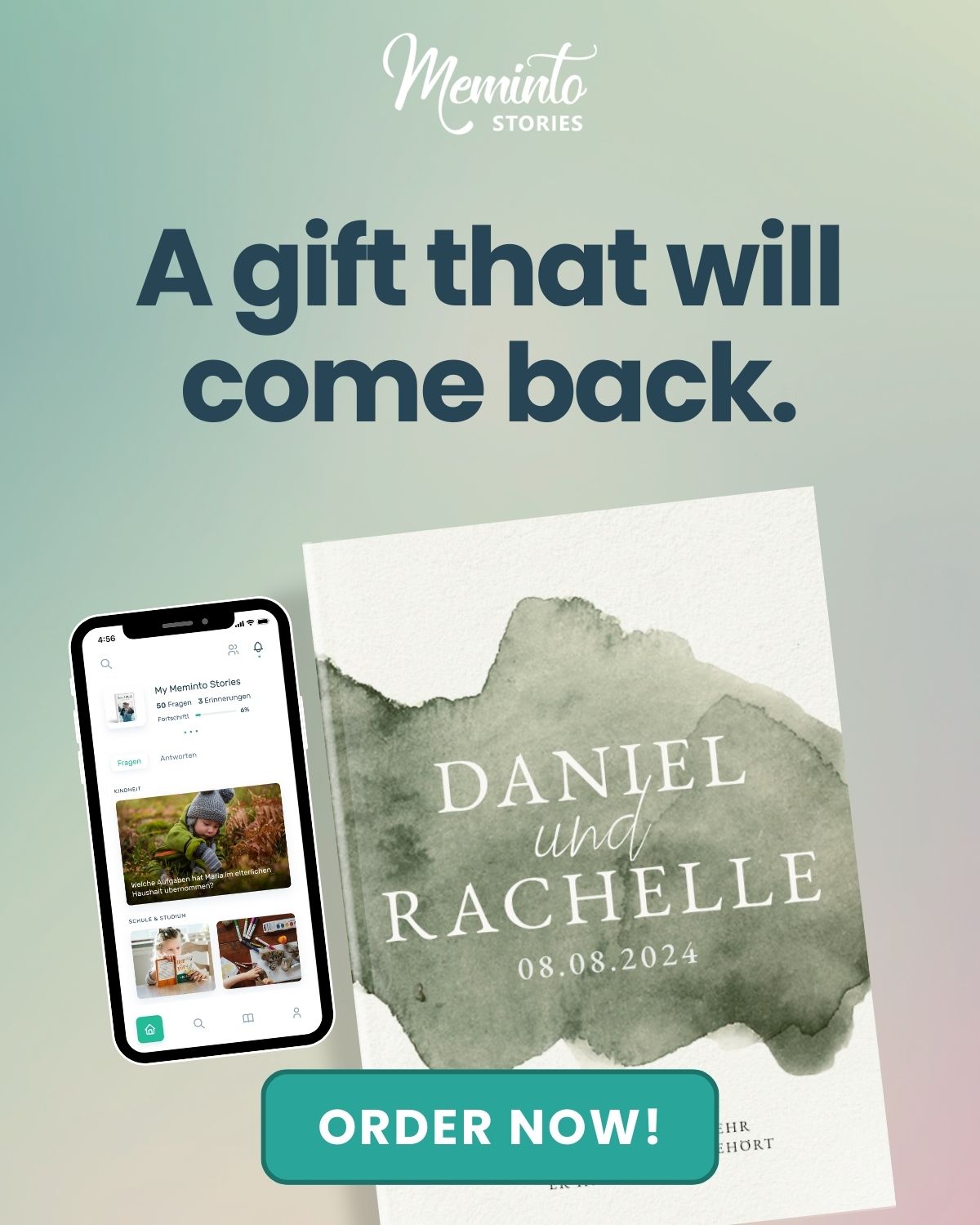You have a story you’re eager to share but not sure where to start. It’s easy to feel overwhelmed, imagining how to piece together entire chapters before you’ve written a single word. Often, we overcomplicate things in our minds before we even begin.
But here’s the truth: Your memoir starts and stops where your story does. There’s no need to plan it all out in advance.
So, how do you begin? That’s exactly what this article will guide you through. We’ll break down a simple structure that works and share steps to get your thoughts flowing. Plus, you’ll find helpful tips to make the process smoother.
Let’s get started!
Key Takeaways
- Your memoir should reflect your unique voice and experiences. Share your story with honesty and vulnerability.
- Instead of covering your entire life, concentrate on specific moments or themes that tie everything together.
- Memory writing platforms like Meminto can simplify the process, helping you organize your memories and add personal touches.
What is a Memoir?
Before we get into the steps, let’s discuss what a memoir is all about. A memoir is a written account of personal experiences. It focuses on specific moments or periods from your life rather than telling your entire life story. Usually we confuse memoirs with autobiographies because of their similarities. However, unlike an autobiography, which covers your life from beginning to end, a memoir zooms in on the parts of your life that hold the most meaning to you.

When you write a memoir, you’re not just telling what happened. You’re exploring how those events affected you, what you learned, and why they matter. The intent is usually to share your experience with readers so they can gain a deeper understanding.
Now that we’ve clarified what a memoir is, let’s go into how to start writing yours.
How to Start Writing a Memoir in 7 Steps
Writing a memoir is no small task, but it’s also what makes memoirs so powerful. And the trick to writing one is to start.
Here’s how you can start your memoir in 7 simple steps:
Decide What Part of Your Life You Want to Share
Your memoir covers a piece of your life, but you have to decide THE piece. So, begin by thinking about what moments or experiences you feel most drawn to. Is it a specific chapter of your life that feels important? Maybe it’s a challenge you overcame or a journey that changed you in some way.
Focusing on one theme or story arc will not only make the writing easier. It will also make your memoir more meaningful and relatable for your readers. Ask yourself: What part of my story do I need to tell right now?
Write the Premise of the Memoir
Before going into the details of your story, it’s important to state the premise of your memoir. The premise is essentially the core idea or message of your memoir. It’s what your story is really about beneath the surface. A clear premise will give your memoir direction, helping you stay focused as you write.
For example, if you’re writing about overcoming adversity, your premise might be: “How I found strength and resilience through personal loss.” This premise will guide the tone, the stories you choose to include, and the overall message you want to leave with your readers.
The premise doesn’t need to be complex, but it should reflect the heart of your story. It’s the “why” behind everything you’re sharing. Once you’ve nailed down your premise, you’ll have a solid foundation to build the rest of your memoir on.
Write a List of all the Important Events
Once you’ve decided on the part of your life you want to share and your memoir’s premise, the next step is to outline the key moments that support your story. These are the events, big or small, that have shaped your experience and align with your memoir’s central theme.
Don’t worry about getting the order right just yet. Just list every significant moment that comes to mind. Think about turning points, challenges, triumphs, and even quieter moments of realization. What conversations, encounters, or decisions changed your perspective? Which memories keep resurfacing, demanding to be told?
For example, if your memoir’s premise is about finding resilience, you might list events like:
- The day you lost your job
- The day you had a heartfelt conversation with a mentor
- Your first time moving to a new city alone
- A difficult breakup that reshaped how you saw yourself
- The moment or day you realized your strength
This list is the backbone of your memoir, so take your time with it. Once you have these events in place, you can begin patching them together. Do remember to always consider your premise. You don’t want to go outside it, or you may end up in confusion.
Write Your First Draft
Now it’s time to get words on the page. Don’t worry about structure, grammar, or perfection. The goal at this stage is to get your memories out of your head and into words, as raw and unfiltered as they may be. Let the emotions and details flow naturally.
Remember, no one’s probably going to see this first draft but you. Allow yourself to revisit the moments you’ve listed without overthinking how they’ll sound. Write as if you’re telling a friend the story for the first time. The only thing that matters here is relieving what you felt and experienced in those moments.
If you’re stuck, start with the memory that feels most vivid. Trust that you’ll have plenty of time later to refine, cut, and rearrange. Right now, just focus on getting the story down. This is where your memoir begins to take shape. Not in the perfect sentences, but in the honesty and vulnerability you bring to your writing.
So, just write.
Take a Break
Once you’ve poured your memories onto the page, it’s time to step back. Writing a memoir is an emotional process, and starting edits too quickly can cloud your perspective. Give yourself at least a week before returning to your draft.
Taking a break allows you to clear your mind and come back to your writing with fresh eyes. During this time, you’ll gain some distance from the intensity of the memories. That will help you see the bigger picture. You might even find that new insights or details surface during this break.
So, take some time away from your draft. Reflect, but don’t overthink. When you come back, you’ll be better prepared to shape your story with clarity and focus.
Read your First Draft and Get the Story Straight
Now that you’ve given yourself some space, return to your draft and see what you’ve created. This step isn’t about nitpicking sentences or fixing typos. You want to get the story right first.
As you read through, ask yourself, Is the heart of my story clear? Do the key events I’ve included support my premise? You want to make sure that the emotions and experiences you’ve written down align with the message you’re trying to convey.
Look at the flow of events. Does your story build naturally? Are there moments that feel out of place or unnecessary? You might notice some memories don’t serve the narrative as well as you thought they would, and that’s okay. Be willing to make adjustments, but don’t worry about making everything perfect just yet. At this stage, the focus is on shaping the structure and making sure the story you’re telling feels true to you.
Reread, Edit, Edit, and Edit Again
Once the story feels solid, you can start the editing process. This is where you refine your writing, polish your sentences, and ensure that your story flows smoothly. Start by rereading your draft, this time with a more critical eye. Look for sections that need tightening, moments that could use more detail, or parts where the emotional impact could be stronger.
While editing, don’t just cut. Sometimes you need to add more depth or reshape a scene to make it clearer or more engaging. Don’t be afraid to make big changes if it helps your memoir come closer to what you envision.
After your first round of edits, take another break. Then, come back and reread again. Each time you edit, your story will become sharper, more focused, and truer to your voice. Memoirs take time to perfect, but with each revision, you’ll get closer to telling your story the way it deserves to be told.


Tips for Writing a Memoir
There are a few extra things to keep in mind to ensure your memoir is both engaging and impactful. Here are some bonus tips to help you along the way:
- Be vulnerable: Share personal emotions and experiences openly. Vulnerability helps readers connect with your story on a deeper level.
- Keep it Concise: A memoir doesn’t have to be bulky. Focus on the most impactful moments that shape your story.
- Use descriptive details: Paint vivid pictures with your words. Let the reader experience the events as you did.
- Stay Authentic: Your voice and perspective should come through clearly. Avoid embellishing facts for dramatic effect.
- Pace Yourself: Don’t rush through important moments. Allow readers time to absorb pivotal points in your journey.
- Edit Ruthlessly: Cut unnecessary details or tangents. Keep your narrative tight and focused on your key message.
- Use a Memory Book App: To make the process easier, you can use a memory book app to organize photos, notes, and ideas as you write. It helps keep everything in one place and can spark inspiration.
Create Beautiful Memories with Meminto
Speaking of memory book apps, Meminto is an excellent tool to help you write and preserve your memoir. It’s designed to make the process easier by guiding you step-by-step, from writing to designing your book.
With Meminto, you can capture life’s important moments and create a beautifully designed memoir that you can share with family and friends. Meminto ensures you don’t miss any of the little details that make your story unique.
See how to use Meminto below.
How to Start a Memoir Writing with Meminto
- Go to https://meminto.com/product/relationship-book/ and click on the “Start Now.”
- Select who will author the book by choosing either “I Will” or “Someone Else Will.”
- Choose the number of pages and input any other options you prefer. This will generate your total, then click “Add to Cart.”
- Type in your shipping details and select how you’d like to pay. If you have a promo code, apply it to get a discount.
- Review and Confirm your order, then track your delivery status from the checkout page.
- Go to your Email for confirmation and activation code, then visit memin.to/register.
- Enter your personal information, activation code, and password. Click “Sign up for Meminto” to start writing your story.
Personal details - Choose your language preference between English and German, then set the day you’d like to receive memory prompts.
- Personalize your memory book by choosing your design preferences.
- Customize the book to fit your needs.
11. Watch the instructional video below so you can get better guidance on how you can use the Meminto app.
You are currently viewing a placeholder content from YouTube. To access the actual content, click the button below. Please note that doing so will share data with third-party providers.
More Information
Wrapping Up
Now you’ve got everything you need to start your memoir. It doesn’t have to be perfect or overly detailed. It just needs to be your story. Focus on the moments that matter most to you and don’t be afraid to let your personality shine through.
Take your time, enjoy the process, and remember, there’s no right or wrong way to tell your story. Just start writing, and before you know it, you’ll have a memoir that’s a true reflection of you.
Cheers!





















